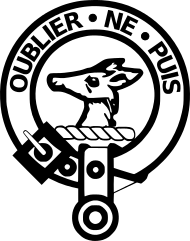Clan Colville
| Clan Colville | |||
|---|---|---|---|
 |
|||
| Motto | Oblier ne puis (I cannot forget) | ||
| Chief | |||
| Charles Colville | |||
| The Rt. Hon. The Viscount of Culross | |||
| Historic seat | Kinnaird Castle | ||
|
|||
Clan Colville is a Lowland Scottish clan.
The Clan Colville chiefs are of ancient Norman origin. The name is probably derived from the town of Colville in Normandy. The first of the name to appear in Scotland was Philip de Colville who is found as a witness to a charter to Dunfermline Monastery some time before 1159. In 1174 Phillip de Colville was one of the hostages used for the release of William the Lion under the Treaty of Falaise. Phillip was also granted the baronies of Oxnam and Hecton in Roxburghshire as well as lands in Ayrshire. Phillip's son was Thomas de Colville who between 1189 and 1199 was a witness to several charters of William the Lion. Thomas was unjustly suspected of treason and was imprisoned in Edinburgh Castle but he later regained royal favor and died on his own estates in 1219. Thomas's son was William de Colville who acquired the barony of Kinnaird in Stirlingshire which remains the chief's seat to this day. In 1228 William de Colville granted a lease of the part of his barony to the Abbot of Holyrood which was confirmed in a charter by Alexander II of Scotland.
The heiress of Sir William Colville was E'stace. She was married to Sir Reginald Cheyne, an elderly knight who died in about 1291, leaving her considerable wealth. E'stace appears on the Ragman Rolls of 1296 swearing fealty to Edward I of England. She is recorded on the Ragman Rolls as holding lands in Aberdeen, Ayr, Banff, Forfar, Inverness and Kincardine. The foundation of the fortunes of the Colvilles is attributed to E'stace's considerable abilities by Alexander Nisbet.
...
Wikipedia
